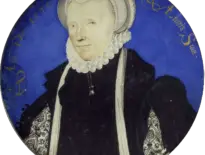Trigger Warning: This video discusses sensitive topics of miscarriage and stillbirth. If you've experienced these, my heart goes out to you.
In my latest video, I unravel the heartbreaking saga of Catherine of Aragon's relentless quest to provide Henry VIII with a male heir, which saw her experiencing six pregnancies between 1509 and 1518, and losing five children.
Here's the transcript:
It’s well known that Catherine of Aragon, Henry VIII’s first wife, failed to give him a surviving male heir. It’s what led to Henry VIII wanting to set her aside and to replace her with Anne Boleyn, it had a major impact: the Great Matter, the break with Rome, the English Reformation, lots of executions, the dissolution of the monasteries, and so on.
But it’s not for lack of trying, is it? Between 1509 and 1518, Catherine was pregnant at least six times. Six pregnancies in 10 years – wow! Sadly, as we know, only one baby survived infancy, a little girl who’d become Queen Mary I.
There’s a poignant memorial at Hampton Court Palace, which always makes me pause and think of poor Catherine. It’s shaped a bit like a tombstone and lists all of Catherine’s pregnancies. It reads:
Unnamed princess, stillborn January 1510
Prince Henry, died aged 7 weeks, 1 January 1511 to 22 February 1511
Unnamed prince, stillborn October 1513
Unnamed prince, died soon after birth February 1515
Princes Mary, survived, 18 February 1516 to 17 November 1558
Unnamed princess, stillborn November 1518.
To go through all that and then get abandoned by your husband for a newer and potentially more fertile model! Well, I guess that’s a story as old as time.
What you will notice from that list of babies is that Catherine didn’t have miscarriages, as is quite often said, she had stillbirths or lost babies shortly after birth. Let me share with you what the primary sources tell us about Catherine’s pregnancies…
In November 1509, five months after his marriage to Catherine, Henry VIII wrote to his father-in-law, Ferdinand II of Aragon, telling him the good news that Catherine was pregnant. Catherine had obviously felt the baby move as Henry wrote that “the child in her womb is alive.” Sadly, on 31st January 1510, Catherine “brought forth prematurely a daughter”. The term miscarriage is generally used for babies lost before the 20 week mark, so I think this loss would count as a stillbirth for it sounds like Catherine was further along.
Catherine had lost her baby, but she was given a ray of hope by her physician. When her abdomen stayed rounded and, in fact, continued to grow, he concluded that she was still pregnant, that she had been pregnant with twins. Even when her periods came back, she clung to the hope and even took to her chambers in March 1510 to prepare for the birth. Eventually, her abdomen decreased in size and it became clear that she hadn’t been pregnant. I can’t quite imagine how Catherine felt, going from loss to hope and back to loss, and then suddenly, she was pregnant again. This time, she carried the baby to term, taking to her chamber just before Christmas 1510 and giving birth to a healthy baby boy in the early hours of New Year’s Day 1511. Four days later, Catherine and Henry’s son was baptised “Henry”, after his father and grandfather. The birth of this prince, who was also Duke of Cornwall, was celebrated with a lavish tournament at Westminster held in Catherine of Aragon’s honour. Catherine’s biographer, Giles Tremlett, writes that this tournament was “the third most expensive spectacle of Henry’s long reign, after his father’s funeral and the deluge of ostentation that would later be known as the Field of Cloth of Gold.” Unfortunately, Catherine and Henry’s joy was shortlived. Henry, Duke of Cornwall, died at Richmond on 22nd February 1511, when he was just 52 days old. He was buried at Westminster Abbey.
Chronicler Edward Hall writes of how the king tried not to show his grief openly, “the more to comfort the queen”, but that Catherine “lyke a naturall woman, made much lamentacion”. I’m not surprised. It was a heavy blow.
It’s not known what happened to little Henry. There is no mention in the records of him being ill and I doubt the tournament would have gone ahead if there had been any worries about his health.
Catherine’s next pregnancy is a little bit of a mystery. A record in the Venetian Archives from early October 1513 states that “A male heir was born to the King of England, and will inherit the crown, the other son having died.” However, there doesn’t seem to be any mention of Catherine giving birth around this time, in the English records. In September 1513, Catherine was acting as regent for Henry VIII while she was campaigning in France and although she wasn’t present at the Battle of Flodden, she did set off from London to rally the troops. Would she really have done that if she’d been heavily pregnant. If she did give birth, the baby must have died shortly after, for there is no further mention of the prince.
Catherine’s next recorded pregnancy was in 1514, but it sadly ended in a stillbirth in that November. The Venetian ambassador recorded that “The Queen has been delivered of a stillborn male child of eight months to the very great grief of the whole court”. Another tragic loss.
Then, in 1515, Catherine became pregnant once more. This time, there was to be joy, for on 18th February 1516, at Greenwich Palace, Catherine gave birth to a healthy daughter. Three days later, the little girl was baptised, being named after her father’s favourite sister, Mary Tudor. At the end of the ceremony, heralds proclaimed, “God send and give long life unto the right high, right noble and excellent Princess mary, Princess of England and daughter of our most dread sovereign lord the King’s Highness.”
Catherine and Henry must have been over the moon and so very relieved. And this little girl survived and became a Queen of England. Catherine still hadn’t given the king a son, though, so it was imperative that they keep trying. In 1518, Catherine became pregnant again, but in November 1518, according to the Venetian ambassador, she went into premature labour at eight months, giving birth to a stillborn daughter.
Historian Julia Fox, in her Book “Sister Queens”, writes of how Catherine didn’t give up hope, going on pilgrimages, attending mass after mass, and praying alone for hours and hours, but it was not meant to be. Catherine did not get pregnant again, and we can only imagine how she felt when her husband’s mistress, one of her ladies, Elizabeth Blount, have birth to a healthy baby boy in 1519 and the ecstatic king acknowledged him, giving him the name Henry Fitzroy and then later raising him to be Duke of Richmond and Somerset.
And then, a few years later, she had to cope with her husband arguing that their marriage had never been valid because she was his brother’s widow. What that poor woman went through as Henry VIII’s queen consort!
Catherine of Aragon was a queen who faced not only the heartbreak of lost children but also the turmoil of a marriage unravelling at the seams and her husband abandoning her and their daughter. The daughter she educated to be a queen was instead made illegitimate and removed from the succession.
Catherine may be removed from us by around 500 years, but I think her story resonates with us as it’s one of resilience, maternal love, loss, and the unyielding spirit of a wife betrayed.



Is she thought to have had an early menopause? It seems very strange that she was so regularly pregnant between 1509 and 1518 and then just stopped, at only 33.
I suspect she stopped getting pregnant because the King had given up on her and had stopped sleeping with her. He would have had mistresses instead, and/or was beginning to woo Anne Boylen by assuring her he was no longer sleeping with his wife.
I suspect she stopped becoming pregnant because the King had given up on her and had stopped sleeping with her. He would have had mistresses instead, and/or was beginning to woo Anne Boylen by assuring her he was not sleeping with his wife.
This was a wonderful and poignant video, Claire! Catherine’s life was so tragic! Has there been any research done as to why her reproductive record was so tragic? If so, I would love to read about it. With 6 pregnancies and only 5 children surviving to adulthood, it seems that there must have been something wrong.
It’s also interesting to note that although Mary survived, she was plagued with health problems throughout her life. Do you think this might have had anything to do with why her siblings didn’t survive?